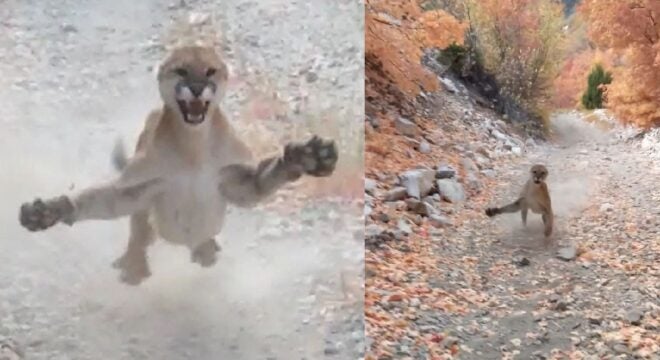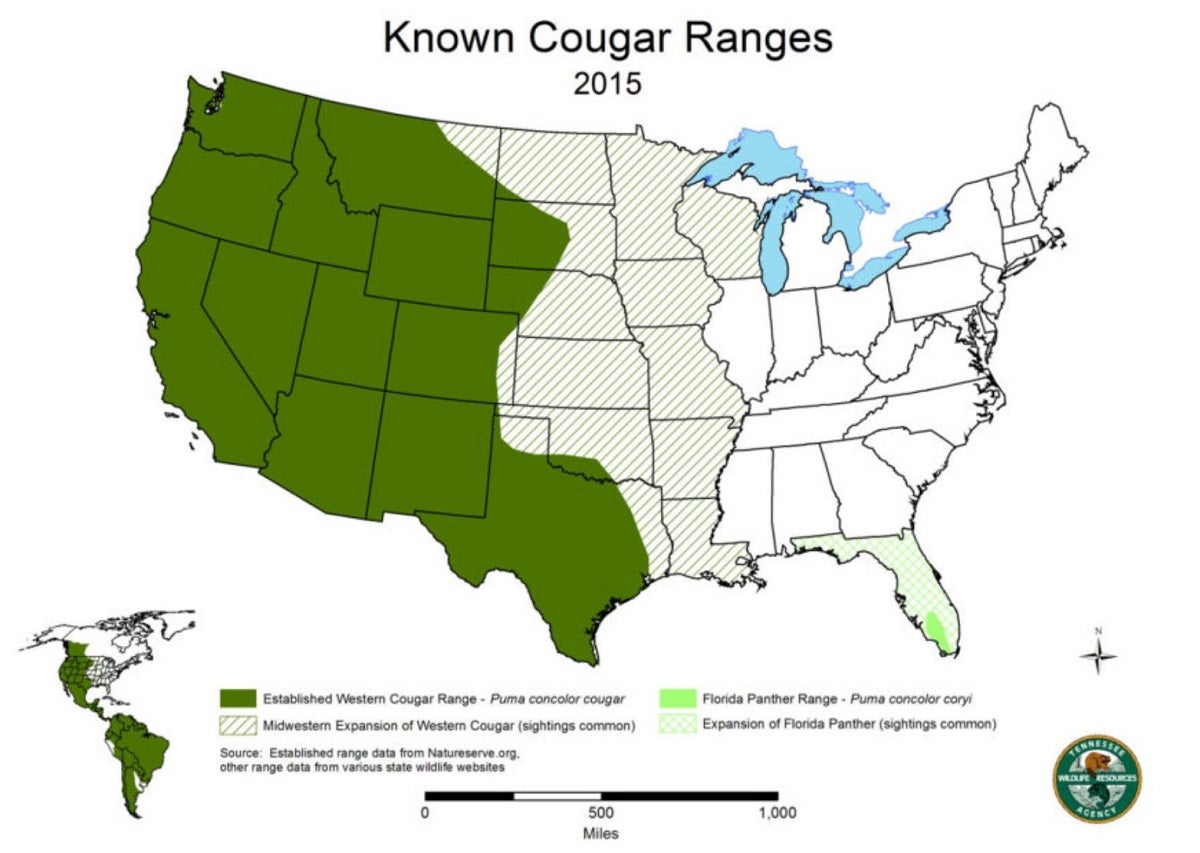Staying Safe Around Mountain Lions & What To Do if You Encounter One
Travis Olander 12.14.23

The still images of the mountain lion above come from a video shot by a hiker in Cottonwood Canyon, Utah, in fall 2020. For six minutes, a female adult cougar stalks the hiker, displaying intense aggression and feigning charges. The not-quite-an-attack was instigated by the hiker’s unfortunate close encounter with the lion’s cub. You can view the original video here. If you analyze the video from start to finish, you’ll witness everything you should (and shouldn’t) do if you encounter a mountain lion — but more on that later.
Photo courtesy Tennessee Wildlife Resources Agency
Mountain lion attacks are relatively rare. Like most wild animals (including bears), the American lion is elusive; it prefers to avoid human contact. But the American wilderness is home to tens of thousands of mountain lions across the west coast and Midwest. Unconfirmed sightings have been reported as far east as New York, and the wilderness throughout the contiguous United States qualifies as suitable cougar habitat. If you frequent the Rockies, or any other pacific or Midwest national park or forest, there is a chance you could encounter a lion. Here’s how to play it safe in mountain lion country, and what to do if you run into one.
How to Avoid a Lion Encounter
Like the video referenced above, many mountain lion encounters are the result of man and beast encountering each other unexpectedly — which usually results in the lion, caught unawares, acting aggressively against the offending person. Reduce the odds of a surprise run-in with a big cat by following these steps.
Make some noise. Making frequent noise on the hiking trail and announcing your presence to wildlife is the best way to avoid an encounter with elusive predators like mountain lions. These cats are more likely to avoid a noisy, unknown intruder than move closer to investigate.
Travel with company. A lone hiker or camper is far more likely to encounter a mountain lion. These predators are opportunistic, and naturally feel inclined to size up single, isolated creature as potential prey. Traveling with a group of people eliminates any chance of inadvertently presenting yourself as easy prey to a stalking lion.
Stick to marked trails. You’re more likely to encounter a lion if you stray from trafficked hiking trails and established campsites. The mountain lion’s natural sources of food — deer, elk, and small critters – like to steer clear of places that people frequent, and lions tend to follow their prey. So, the further away you stay from the prey’s habitats, the less likely you are to run into a lion.
Separate food from camp. Mountain lions primarily stalk and hunt prey animals. But juvenile lions, which are often responsible for reported encounters, are more opportunistic and curious. They may feel inclined to investigate the smell of food — like the beef jerky or smoked venison you stuffed in your backpack. To avoid encounters with any wildlife, it’s a good idea to keep your foodstuffs far away from your campsite.
Stay away from lion cubs. The unfortunate Utah hiker who dealt with a hissing lion wound up just meters from the lion’s cub, which spurred the lion’s aggressive posturing. Lions typically birth one to four cubs at a time, and their population growth is accelerating. Lions with cubs are also likely to increase their range in search of food.
That means you could run into a pack of lions — an adult with cubs. But this type of encounter is guaranteed to invite aggressive behavior, and potentially a defensive attack. If you see lion cubs, immediately exit the area in the same direction you came.
What To Do If You Encounter a Mountain Lion
If you love the outdoors and you live in lion country, you’re bound to cross through the territory of a big cat once or twice. Chance encounters are not uncommon. Lest you become the next hiker to grab some shaky cell phone footage of an angry cougar somewhere in a canyon, follow these steps during an encounter.
Do not run. Running into a large predator in the wilderness will instantly trigger your fight-or-flight instincts. Follow the former; do not ever turn and run from a cougar. This is certain to trigger the cat’s predator response — they almost universally take prey by chasing and attacking from behind.
Look big. Make yourself look bigger to the cat. Open your jacket, raise your arms and spread your legs, and face the lion at all times. If you have trek poles or any objects handy, wave them around — and be prepared to use them to defend yourself.
Make noise. Speak loudly, and make as much noise as possible. There are plenty of anecdotes of people scaring away mountain lions with loud music (Metallica, in particular) played from a speaker or smartphone.
Maintain eye contact. You may have been told that staring down an animal is considered a challenge that could invite an attack — especially with dogs — but, in this case, maintaining eye contact with the lion is a best practice.
Stand your ground. If the lion challenges you by approaching from a distance, stand your ground. To the lion, only prey animals retreat. Lions don’t recognize a standing human as a typical prey animal. Standing your ground reinforces this fact.
Throw objects and retreat. But if the distance between you and a curious mountain lion closes to an uncomfortable degree, it’s time to act in self-defense: Throw rocks, sticks, and other nearby objects in the cat’s direction, and slowly walk backward to put space between you and the cat.
If a Mountain Lion Attacks
Do everything to fight back. Adult male lions weigh 135 to 175 pounds, while females weigh between 90 and 105 pounds. These are powerful creatures with sharp claws and strong bites, but they aren’t insurmountable — and, if you’re attacked, there’s nothing better to do than to fight back. Mountain lions usually attack the head and neck; do your best to protect these areas by remaining upright and facing the cat during the attack. Use any weapon available to you. A sharp crack to the skull with a rock, or a blow to the body with a pocket knife or any other sharp implement, could be enough to end the attack.
Immediately Report All Sightings
If you see a mountain lion near any area frequented by people, immediately contact your local authorities. If you’re near a state park or forest, contact park officials or your state’s Department of Wildlife. If no contact information for rangers or DNR services are available, or if you see a lion near an urban area, contact your local sheriff’s office or police department — they’ll either respond directly, or contact the appropriate wildlife service.
